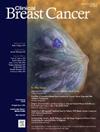Biologically Informed Decision-Making for PMRT in pT3N0M0 Luminal Breast Cancers (Protocol MF22-02): International Multicenter Real-World Data
IF 2.5
3区 医学
Q2 ONCOLOGY
引用次数: 0
Abstract
Background
Current guidelines do not list definitive recommendations for postmastectomy radiation therapy (PMRT) in patients with luminal pT3N0M0 breast cancer (BC). Increased data suggests de-escalation of radiation therapy (RT) in genomically defined biologically favorable luminal BCs. The goal of this study is to determine whether PMRT can be safely omitted for this specific subgroup of patients.
Methods and materials
Two hundred and 2 women from 16 centers with pT3N0M0 hormone receptor (HR) positive, HER2 negative BC who underwent mastectomy were retrospectively analyzed. No patients received neoadjuvant chemotherapy. Three patients were excluded because of positive surgical margins. Patients were divided into 2 groups: PMRT (n = 130) and no PMRT (n = 69). Groups were compared in terms of overall survival (OS), loco-regional recurrence (LRR) rate, and distant metastases (DM) in light of the Magee Equations Score (MS), menopausal status/age, axillary surgery, pathology, lymphovascular invasion (LVI), adjuvant chemotherapy, and adjuvant endocrine therapy.
Results
The majority of the patients had invasive ductal carcinoma (49%, n = 98). There was no significant difference regarding tumor size, axillary surgery, and adjuvant endocrine therapy between the 2 groups (P = .82, P = .28, P = .12, respectively). LVI was 19% (n = 39), and it was greater in the PMRT group (25% vs. 10%; P = .01). Patients in the PMRT group received more chemotherapy (66% vs. 30%; P < .001), had more grade 3 tumors (28% vs. 9%, P = .005), and were more premenopausal (49% vs. 22%; P = .0001). At a median follow-up of 51.3 months for the no PMRT group and 65.9 months for the PMRT group (P = .041), 9% (n = 6) of patients from the no PMRT group and 2% (n = 3) from the PMRT group developed LRR (P = .047). There was no difference in local recurrence (1% in no PMRT group vs. 2% in PMRT group; P = .7) and distant recurrence (7% in no PMRT group vs. 3% in PMRT group; P = .16) in patients who received PMRT and no PMRT. Further comparison of the LRR in the no PMRT and PMRT groups in patients with an MS < 18 did not show a significant difference (3% vs. 4%; P = .64). However, among patients with an MS ≥ 18, no PMRT group had a higher LRR rate compared to the PMRT group (11% vs. 2%; P = .01). In patients with an MS ≥ 18, the administration of PMRT correlates with statistically significantly better LRR-free survival (HR 0.19; 95% CI 0.05-0.79; P = .02).
Conclusions
Our findings imply that when considering PMRT for patients with pT3N0M0, HR-positive, and HER2-negative BC, clinicians can benefit from a combination of pathological risk factors and recurrence prediction models. Patients with MS < 18 experience a comparable rate of recurrence irrespective of PMRT, while those with MS ≥ 18 have higher rates of LRR and thus should not omit PMRT.
pT3N0M0腔内乳腺癌PMRT的生物学知情决策(方案MF22-02):国际多中心真实世界数据。
背景:目前的指南并没有列出对腔内pT3N0M0型乳腺癌(BC)患者的乳房切除术后放射治疗(PMRT)的明确建议。越来越多的数据表明,在基因组定义的生物学有利的管腔bc中,放射治疗(RT)的降级。本研究的目的是确定PMRT是否可以安全地用于这一特定亚组患者。方法与材料:回顾性分析来自16个中心的202例pT3N0M0激素受体(HR)阳性、HER2阴性的乳腺癌行乳房切除术的患者。无患者接受新辅助化疗。3例患者因手术切缘阳性而被排除。患者分为两组:经PMRT治疗组(n = 130)和未经PMRT治疗组(n = 69)。根据Magee方程评分(MS),绝经状态/年龄,腋窝手术,病理,淋巴血管侵袭(LVI),辅助化疗和辅助内分泌治疗,比较各组的总生存率(OS),局部区域复发率(LRR)和远处转移(DM)。结果:绝大多数患者为浸润性导管癌(49%,n = 98)。两组患者在肿瘤大小、腋窝手术及辅助内分泌治疗方面差异均无统计学意义(P = 0.82、P = 0.28、P = 0.12)。LVI为19% (n = 39), PMRT组LVI更高(25% vs. 10%;P = 0.01)。PMRT组患者接受更多化疗(66% vs. 30%;P < 0.001),有更多的3级肿瘤(28% vs. 9%, P = 0.005),绝经前(49% vs. 22%;P = 0.0001)。无PMRT组和PMRT组的中位随访时间分别为51.3个月和65.9个月(P = 0.041),无PMRT组和PMRT组分别有9% (n = 6)和2% (n = 3)的患者出现LRR (P = 0.047)。局部复发率无差异(无PMRT组为1%,PMRT组为2%;P = .7)和远处复发率(无PMRT组7% vs. PMRT组3%;P = 0.16)。进一步比较无PMRT组和PMRT组在MS < 18患者中的LRR没有显示出显著差异(3% vs. 4%;P = .64)。然而,在MS≥18的患者中,没有PMRT组的LRR率高于PMRT组(11% vs 2%;P = 0.01)。在MS≥18的患者中,PMRT的使用与更好的无lrr生存相关(HR 0.19;95% ci 0.05-0.79;P = .02)。结论:我们的研究结果表明,当考虑对pT3N0M0、hr阳性和her2阴性BC患者进行PMRT时,临床医生可以从病理危险因素和复发预测模型的组合中获益。不论是否进行PMRT, MS < 18的患者的复发率相当,而MS≥18的患者的LRR率较高,因此不应省略PMRT。
本文章由计算机程序翻译,如有差异,请以英文原文为准。
求助全文
约1分钟内获得全文
求助全文
来源期刊

Clinical breast cancer
医学-肿瘤学
CiteScore
5.40
自引率
3.20%
发文量
174
审稿时长
48 days
期刊介绍:
Clinical Breast Cancer is a peer-reviewed bimonthly journal that publishes original articles describing various aspects of clinical and translational research of breast cancer. Clinical Breast Cancer is devoted to articles on detection, diagnosis, prevention, and treatment of breast cancer. The main emphasis is on recent scientific developments in all areas related to breast cancer. Specific areas of interest include clinical research reports from various therapeutic modalities, cancer genetics, drug sensitivity and resistance, novel imaging, tumor genomics, biomarkers, and chemoprevention strategies.
 求助内容:
求助内容: 应助结果提醒方式:
应助结果提醒方式:


